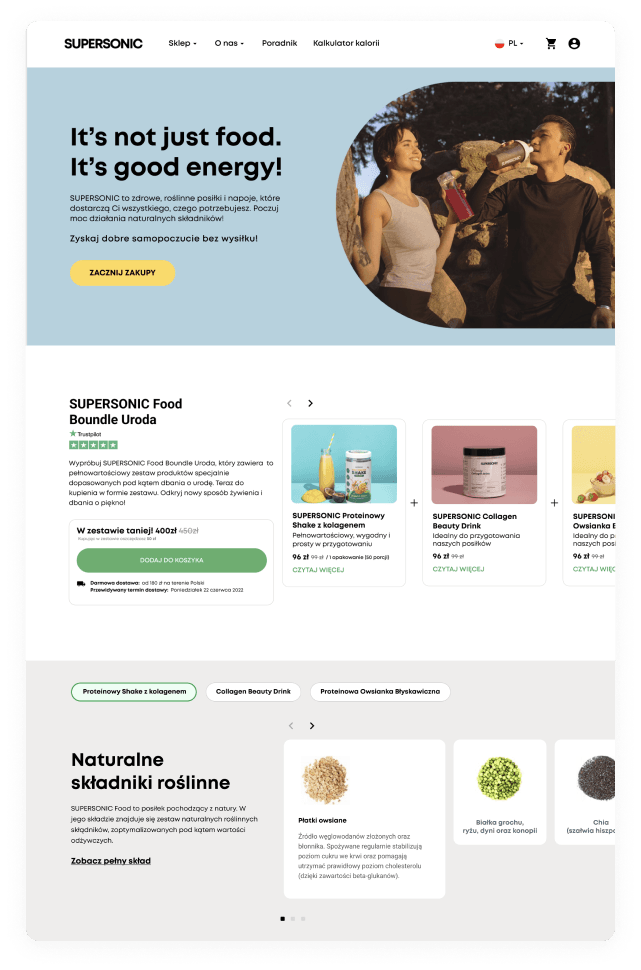

UX Audits – websites, e-commerce and apps
The goal of a UX audit is to identify areas where UX can be improved and recognize issues that may affect user satisfaction. Based on the collected data and analysis, we can propose specific solutions, such as changes to the page layout or improvements to navigation.

What is a UX audit?
A UX audit is the process of evaluating and analyzing the user experience (UX) to identify strengths, weaknesses, opportunities, and threats related to UX in a given product, website, or application. It is an important tool that helps improve interactions and services to provide users with the best possible experience.
Increasing conversion rates
By analyzing user behaviors and optimizing conversion paths, a UX audit can contribute to increasing the number of achieved goals, such as purchases, registrations, or file downloads.
Improving user satisfaction
A UX audit allows for the identification of usability issues with a website or application. As a result, improvements can be made to increase user satisfaction and encourage them to more willingly use the offered services.
Time and money savings
Investing in a audit at an early stage of a project helps avoid revisions in the future. Identifying and resolving issues at the design stage is cheaper than making changes after implementation.
Increasing user engagement
Good user experiences lead to increased engagement, which translates into longer time spent on the website and more interactions.
Building a positive brand image
A website or application that is easy to use and provides positive experiences builds a positive brand image in the eyes of users. This, in turn, translates into customer loyalty and a greater willingness to recommend the brand to others.

Supersonic Food – Food of the Future. Health food store.

Our cooperation with SUPERSONIC Food began with store optimization, and after a few months it turned into full maintenance of the e-commerce website. Thanks to our cooperation with SUPERSONIC Food, we managed to achieve results that resulted in increased sales and improved website use (User Experience).
I recommend cooperation with Codeq to everyone looking for a dedicated e-commerce partner. Their holistic approach to e-commerce development, maintenance and security was crucial to the success of our online store.
Chris Kozak Founder @ SuperSonic FoodUser experience audit benefits
A user experience (UX) audit is a process of evaluating and analyzing the UX of a product, website, or application to identify areas for improvement and address any issues that may impact user satisfaction. Conducting a UX audit offers several benefits:
Identifying areas for improvement
A UX audit helps pinpoint specific areas where the UX can be enhanced, such as the layout, navigation, or overall usability. By identifying these areas, businesses can make targeted improvements to enhance the user experience.
Enhancing user satisfaction
By addressing UX issues and making improvements based on the audit findings, businesses can enhance user satisfaction. A positive user experience leads to increased engagement, longer time spent on the site, and a higher likelihood of users returning.
Increasing conversions
A UX audit can identify barriers or friction points in the conversion process, such as complex forms or confusing navigation. By optimizing the conversion paths and making the necessary improvements, businesses can increase the number of conversions, whether it’s making a purchase, signing up, or downloading files.
Saving time and money
Investing in a UX audit early in the project can help avoid costly revisions and changes in the future. By identifying and resolving issues during the design stage, businesses can save time and resources that would otherwise be spent on post-implementation changes.
Building a positive brand image
A website or application that provides a seamless and positive user experience helps build a positive brand image. When users have good experiences, they are more likely to develop loyalty towards the brand and recommend it to others, contributing to a positive brand reputation.
In summary, a UX audit offers numerous benefits, including identifying areas for improvement, enhancing user satisfaction, increasing conversions, saving time and money, and building a positive brand image.
UX audit – when is it worth it?
A UX audit is worth considering in several situations:
Redesign or relaunch
If you are planning a redesign or relaunch of your website or application, a UX audit can help identify areas for improvement and ensure that the new design meets user needs and expectations.
Drop in performance metrics
If you notice a decline in key performance metrics, such as conversion rates or user engagement, a UX audit can help uncover usability issues or barriers that may be impacting user satisfaction and hindering desired actions.
User feedback indicates issues
If you receive consistent feedback from users about usability problems or frustrations with your website or application, a UX audit can help pinpoint these issues and provide actionable recommendations for improvement.
Competitive disadvantage
If your competitors are offering better user experiences and gaining a competitive edge, a UX audit can help you identify areas where you can improve and catch up with or surpass your competition.
New product or feature launch
When introducing a new product or feature, conducting a UX audit can help ensure that the user experience is optimized from the start, avoiding potential issues and increasing the chances of success.
Ultimately, a UX audit is worth considering whenever you want to improve the user experience of your digital product, address specific usability issues, or stay ahead of the competition. It provides valuable insights and recommendations for enhancing the usability, engagement, and overall satisfaction of your users.
Conducting a UX audit step by step
Conducting a UX audit involves several steps to thoroughly evaluate and analyze the user experience of a product, website, or application. Here is a step-by-step guide:
- Define the objectives: Start by clearly defining the objectives of the UX audit. Determine what specific aspects of the user experience you want to assess and improve.
- Gather user data: Collect relevant user data to gain insights into user behavior and preferences. This can include analytics data, user feedback, surveys, and usability testing results.
- Evaluate usability: Assess the usability of the product by examining factors such as navigation, layout, content organization, and interaction design. Identify any pain points or areas where users may encounter difficulties.
- Analyze user flows: Analyze the user flows and conversion paths within the product. Identify any bottlenecks or barriers that may hinder users from completing desired actions, such as making a purchase or signing up.
- Review visual design: Evaluate the visual design elements, including color schemes, typography, imagery, and overall aesthetics. Ensure that the design aligns with the brand identity and enhances the user experience.
- Conduct heuristic evaluation: Apply established usability heuristics or guidelines to assess the overall user experience. Look for violations of these principles and identify areas for improvement.
- Identify pain points: Based on the data and evaluations, identify specific pain points or areas where the user experience can be enhanced. These could include confusing navigation, slow loading times, or complex forms.
- Generate recommendations: Develop actionable recommendations to address the identified pain points and improve the user experience. Prioritize the recommendations based on their impact and feasibility.
- Create a roadmap: Create a roadmap or action plan that outlines the recommended improvements, along with timelines and responsibilities. This will guide the implementation of the changes.
- Monitor and iterate: Continuously monitor the impact of the implemented changes and gather feedback from users. Iterate and refine the user experience based on user insights and evolving needs.
Remember, the specific steps and depth of the UX audit may vary depending on the scope and complexity of the project. It’s essential to tailor the process to meet the specific needs and goals of your project.
Trust our workflow
Great information architecture and comfortable navigation help users achieve their goals on your website. Build a website with us.
Discovery
During the discovery phase, we collect all the necessary data that allows us to make informed decisions in the following stages of the project. It helps us co-create a clear roadmap and product backlog (not sure what you mean by backlog here, maybe replace this with strategy).
Design
The UX and design phase consist of visualizing a previously developed concept. We recreate the information architecture and actualise your business goals through UX. Finally, the digital product comes to life with a specific visual style that aligns with your brand identity.
Development
Using the right tools and tech stack, everything from discovery and design is transformed into the language of technology. Every solution is complemented by extensive testing from a wide range of devices.
Support
The implementation of a digital product is only the beginning of the adventure. We offer support with maintenance and further development and are continuously present for our clients. Equipped with analytical data, we can create hypotheses and conduct A / B tests.
They trusted us
I recommend cooperation with Codeq to everyone looking for a dedicated e-commerce partner. Their holistic approach to e-commerce development, maintenance and security was crucial to the success of our online store.
UX audits services for websites, e-commerce, and apps by Codeq
A UX audit is a process of evaluating the user experience of a website, e-commerce platform, or mobile app. It involves analyzing various aspects of the user interface, usability, and overall user experience to identify areas of improvement provide recommendations for enhancing the user experience.
Website UX Audit
A website UX audit is a process of evaluating the user experience of a website. It involves analyzing various aspects of the website’s design, functionality, and usability to identify areas of improvement. During a website UX audit, experts assess factors such as navigation, layout, content organization, visual design, and overall user interaction. The goal is to identify any issues or pain points that may be affecting the user experience and provide recommendations for enhancing it. This can lead to improved user satisfaction, increased engagement, and better overall performance of the website.
Example: Imagine you have a website for an online store. A website UX audit would involve evaluating how easy it is for users to navigate through different product categories, how visually appealing and organized the product pages are, and how smoothly the checkout process functions. Based on the findings of the audit, recommendations may be made to improve the website’s user experience, such as simplifying the navigation menu, optimizing the layout for mobile devices, or enhancing the search functionality.
E-commerce UX Audit
An e-commerce UX audit focuses specifically on evaluating the user experience of an e-commerce platform or online store. It involves assessing various elements such as product listings, shopping cart functionality, checkout process, payment options, and customer support. The goal is to identify any barriers or friction points that may be hindering the user’s ability to browse, select, and purchase products. By conducting an e-commerce UX audit, businesses can gain insights into how to optimize their platform to improve user satisfaction, increase conversions, and drive sales.
Example: Let’s say you have an e-commerce platform where users can purchase clothing. An e-commerce UX audit would involve evaluating how easily users can find and filter products, how clear and informative the product descriptions are, how intuitive the shopping cart and checkout process is, and how responsive the customer support is. Based on the audit findings, recommendations may be made to streamline the purchasing journey, simplify the checkout process, or enhance the product presentation to improve the overall e-commerce user experience.
Application UX Audit
An application UX audit focuses on evaluating the user experience of a mobile or desktop application. It involves analyzing various aspects such as the app’s interface design, navigation, usability, performance, and overall user satisfaction. During an application UX audit, experts assess factors like the clarity of the app’s layout, ease of use, responsiveness, and the effectiveness of user interactions. The goal is to identify any usability issues, design flaws, or areas for improvement to enhance the user experience and increase user engagement.
Example: Consider a social media app. An application UX audit would involve evaluating how easily users can navigate through different sections of the app, how intuitive the interface is for performing actions like posting, commenting, or sharing content, and how quickly the app responds to user interactions. Based on the audit findings, recommendations may be made to improve the app’s navigation structure, simplify the user interface, or optimize the app’s performance to provide a better overall user experience.
Digital Products UX Audit
A digital products UX audit is a broader term that encompasses the evaluation of various digital products, including websites, e-commerce platforms, and applications. It involves assessing the user experience of these digital products to identify areas of improvement and provide recommendations for enhancing the overall user experience. By conducting a digital products UX audit, businesses can gain insights into how to optimize their digital products to meet user needs, improve satisfaction, and achieve their business goals.
Example: Let’s say you have a company that offers a range of digital products, including a website, an e-commerce platform, and a mobile app. A digital products UX audit would involve evaluating the user experience of each of these products individually, as well as how they work together as a cohesive user journey. The audit would assess factors like navigation, design consistency, usability, and overall user satisfaction across all the digital products. Based on the audit findings, recommendations may be made to improve the user experience of each individual product and ensure a seamless experience for users across all the digital touchpoints.
UX audits for digital products
A UX audit for digital products is a process of evaluating the user experience of various digital products, such as websites, e-commerce platforms, and applications. It involves analyzing different aspects of these products, including their design, functionality, and usability, to identify areas of improvement and provide recommendations for enhancing the overall user experience.
During a UX audit for digital products, experts assess factors such as navigation, layout, visual design, content organization, interaction patterns, and overall user satisfaction. The goal is to identify any pain points, usability issues, or design flaws that may be hindering the effectiveness of these digital products. By conducting a UX audit, businesses can gain valuable insights into how to optimize their digital products to meet user needs, improve user satisfaction, and achieve their business goals.
For example, let’s say you have a company that offers a website, an e-commerce platform, and a mobile app. A UX audit for your digital products would involve evaluating each of these products individually, as well as how they work together as a cohesive user journey. The audit would assess factors like navigation ease, visual appeal, responsiveness, and overall user satisfaction across all the digital products. Based on the audit findings, recommendations may be made to improve the user experience of each individual product and ensure a seamless experience for users across all the digital touchpoints.
In summary, a UX audit for digital products helps businesses identify any usability issues, design flaws, or areas for improvement in their websites, e-commerce platforms, and applications. By implementing the recommendations from the audit, businesses can enhance the user experience, increase user satisfaction, and ultimately achieve better results with their digital products.
What do we inspect? UX audit checklist
In a UX audit, there are several key areas that typically inspected to evaluate the user experience of a digital product. While the specific checklist may vary depending on the context and goals of the audit, here are some common elements that are often included:
- User Interface (UI) Design: This involves assessing the visual design of the product, including the use of colors, typography, icons, and overall aesthetics. It also includes evaluating the consistency and clarity of the design elements throughout the product.
- Navigation and Information Architecture: This focuses on evaluating the ease of navigation within the product, including the organization of content, menu structure, and the availability of clear and intuitive pathways for users to find what they need.
- Usability and Interaction Design: This involves assessing how easily users can interact with the product and perform tasks. It includes evaluating the clarity of instructions, the intuitiveness of user flows, the effectiveness of interactive elements, and the overall ease of use.
- Content and Messaging: This focuses on evaluating the quality and relevance of the content within the product, including the clarity of messaging, the accuracy of information, and the alignment with user needs and expectations.
- Accessibility: This involves assessing the product’s compliance with accessibility standards and guidelines, ensuring that it can be used by individuals with disabilities or impairments.
- Performance and Loading Speed: This focuses on evaluating the speed and performance of the product, including the loading time of pages or screens, the responsiveness of interactive elements, and the overall smoothness of the user experience.
- Mobile Responsiveness: This involves evaluating how well the product adapts to different screen sizes and devices, ensuring a seamless user experience across desktop, mobile, and tablet devices.
- Error Handling and Feedback: This focuses on evaluating how the product handles errors, provides feedback to users, and guides them through the error resolution process.
- Conversion and Business Goals: This involves assessing how well the product supports the achievement of business goals, such as conversions, sign-ups, or sales. It includes evaluating the effectiveness of calls-to-action, forms, and other elements that drive user engagement and conversions.
It’s important to note that the specific checklist for a UX audit may vary depending on the specific goals and context of the audit. The checklist can be customized to focus on the areas that are most relevant to the particular digital product and its target audience.
Tools we use at work
Benefits of collaborating with Codeq
A 12 month warranty
The quality of work is not only empty promises. The warranty will give you assurance that our solution will be free from defects.
An experienced and well-coordinated project team
We employ the best WordPress and Shopify Developers in Poland with many years of commercial experience. We provide the highest quality of code and ongoing communication.
Efficient communication and project management
The refined and tested project management process and the continuous care of the Project Manager guarantee uninterrupted access to the status of our projects.
Technological polyglots
There are many specialists of various technologies on board our team. Thanks to them we are able to be your eyes and ears in the constantly changing world of technology.
Let’s discuss your idea!
Free consultation with an expert – maximum focus on your idea
An analysis of challenges and issues in the field of UX Design and Development
Recommendations for best practices in UX Design and Development
A comprehensive implementation plan from start to finish











